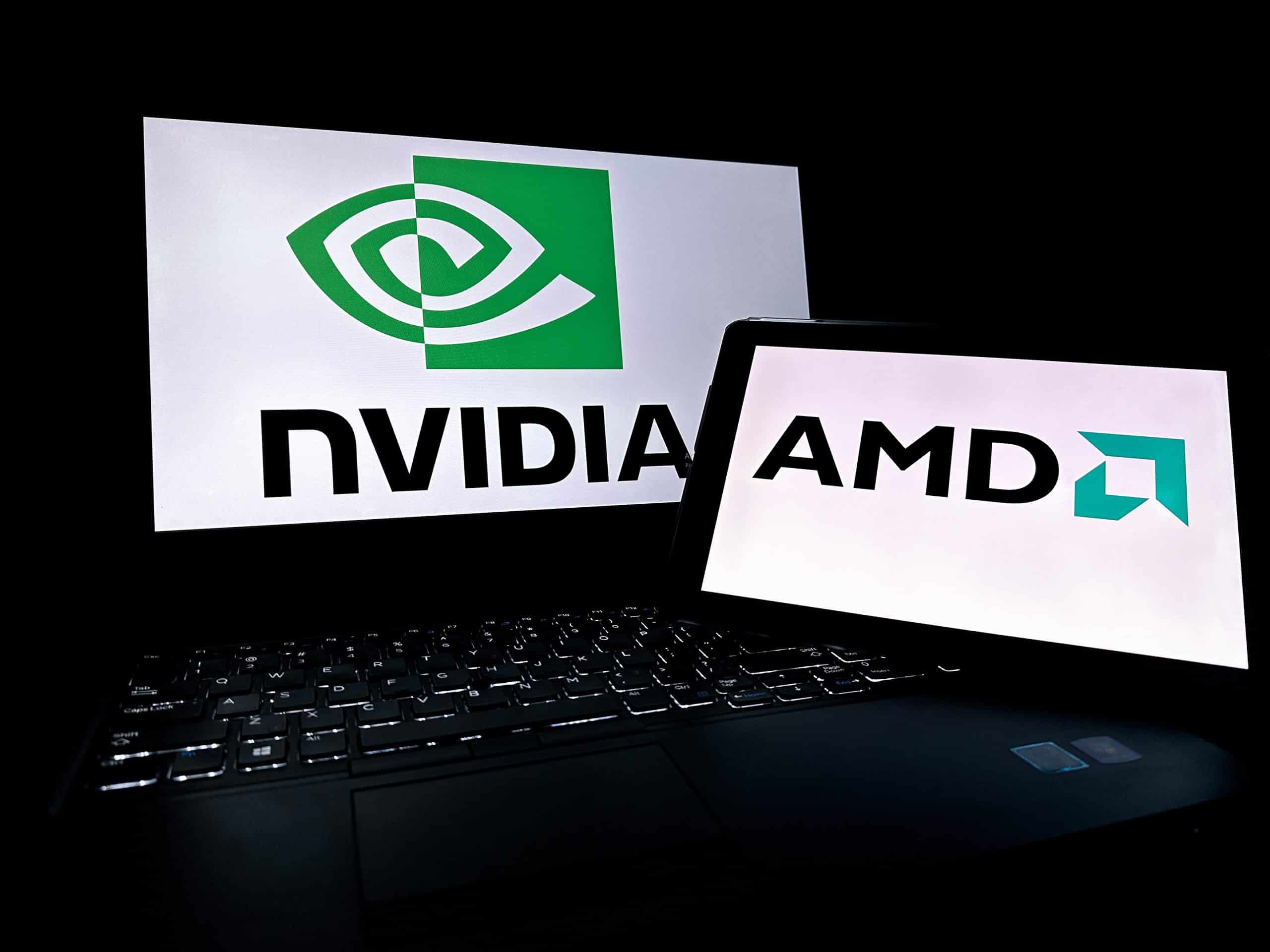The global semiconductor industry is in the midst of a historic growth cycle, driven by breakthroughs in artificial intelligence, data centers, cloud computing, and gaming. Two companies stand at the forefront of this transformation — NVIDIA (NVDA) and Advanced Micro Devices (AMD). While both benefit from rising demand, they operate under distinct business models, growth trajectories, and capital strategies. The latest financial and operational metrics reveal stark differences in scale, profitability, and investor returns. This article dives deep into the data, offering a side-by-side analysis of the two giants and what it means for the broader market.
Quantitative Overview: A Clear Gap in Scale
Market Capitalization – NVIDIA commands a staggering $4.4 trillion market cap, more than 15 times AMD’s $283 billion valuation. This enormous gap reflects NVIDIA’s dominance in AI and GPU markets, as well as its pivotal role in data center infrastructure.
Revenue (TTM) – NVIDIA’s trailing 12-month revenue stands at $149 billion, compared to just $28 billion for AMD. That’s over five times the size, highlighting NVIDIA’s deep penetration into hyperscale data centers, AI platforms, and enterprise computing.
Three-Year Revenue Growth – NVIDIA has delivered an extraordinary 71% growth over the past three years, far outpacing AMD’s 14%. This acceleration underscores the explosive demand for NVIDIA’s AI hardware and software ecosystem.
Profitability and Operating Efficiency
Gross Margin – NVIDIA enjoys a gross margin of 70%, an industry-leading figure that reflects its ability to price products at a premium, particularly in AI-focused GPUs. AMD’s gross margin of 54% is strong for the semiconductor sector but trails significantly behind.
Operating Margin – The gap widens here: NVIDIA posts a 58% operating margin, compared to AMD’s 10%. This speaks not only to superior cost control but also to the competitive advantage NVIDIA enjoys in high-value segments.
Return on Invested Capital (5-Year ROIC) – NVIDIA’s ROIC of 75% versus AMD’s 20% shows the efficiency with which NVIDIA deploys capital, converting investment into profit and shareholder value at a much faster rate.
Cash Flow, Valuation, and Financial Flexibility
Free Cash Flow (TTM) – NVIDIA generates a colossal $72 billion in free cash flow annually, compared to AMD’s $3 billion. This allows NVIDIA to fund aggressive R&D, pursue acquisitions, and return capital to shareholders while maintaining a strong balance sheet.
Forward Price-to-Earnings (P/E) – Interestingly, NVIDIA’s forward P/E sits at 36, lower than AMD’s 42. This could suggest the market expects AMD’s earnings to grow at a relatively faster pace in the near future, or that NVIDIA is already priced as a mature, dominant player.
Cash Reserves – NVIDIA holds $54 billion in cash, almost eight times AMD’s $7 billion. This financial flexibility gives NVIDIA significant room to navigate market downturns, invest in next-generation technology, and execute large-scale acquisitions.
Shareholder Returns and Market Performance
5-Year Total Return – The most striking figure of all: NVIDIA’s shareholders have seen a 1,474% return over five years, compared to 91% for AMD investors. This massive divergence is a direct result of NVIDIA’s early and aggressive positioning in AI infrastructure.
Strategic Comparison: Two Very Different Playbooks
Business Model – NVIDIA has built a specialized product ecosystem for AI, high-performance computing (HPC), and graphics, anchored by proprietary software frameworks such as CUDA. AMD operates across a broader spectrum, including CPUs for personal computers, gaming consoles, and server processors, while competing with both Intel in CPUs and NVIDIA in GPUs.
Technological Advantage – NVIDIA’s leadership is reinforced by its vertically integrated approach, offering hardware, software, and developer tools. AMD, while technologically competitive in many product lines, often focuses on delivering high performance at more accessible price points, appealing to price-sensitive segments.
Capital Allocation Strategy – NVIDIA’s vast cash reserves and strong cash flow generation allow for large-scale investment in R&D, strategic acquisitions, and ecosystem development. AMD, with a smaller capital base, invests more selectively, but has still achieved notable product successes with its Ryzen CPUs and EPYC server processors.
The Investor Perspective
The data paints a clear picture: NVIDIA holds a commanding lead in scale, profitability, and market influence. AMD, however, remains a formidable competitor with a diversified product lineup and opportunities to expand in data center and AI markets.
For investors, the choice between these two companies comes down to strategic preference:
NVIDIA represents a dominant, highly profitable market leader with proven growth in AI and data centers.
AMD offers a more affordable entry point into the semiconductor sector with the potential for faster percentage growth if it successfully expands market share.
Key Risks and Considerations
For NVIDIA – The biggest risks include regulatory scrutiny over its dominance, potential slowdowns in AI hardware demand, and reliance on a few high-growth segments that could see cyclical downturns.
For AMD – Risks include intense price competition, reliance on external manufacturing (TSMC), and the challenge of catching up to NVIDIA’s entrenched AI ecosystem.
Conclusion
The NVIDIA vs AMD rivalry is not a battle of equals — at least for now. NVIDIA’s dominance in AI, unmatched profitability, and extraordinary investor returns place it in a league of its own. AMD, while smaller in scale, remains an innovative challenger with a track record of breaking into competitive markets and delivering strong relative growth.
As AI adoption accelerates, both companies stand to benefit — but NVIDIA’s head start, scale, and ecosystem give it a distinct advantage. AMD’s path to closing the gap will likely depend on targeted innovation, competitive pricing, and strategic partnerships.
Comparison, examination, and analysis between investment houses
Leave your details, and an expert from our team will get back to you as soon as possible
* This article, in whole or in part, does not contain any promise of investment returns, nor does it constitute professional advice to make investments in any particular field.
To read more about the full disclaimer, click here- Articles
- •
- 8 Min Read
- •
- ago 33 minutes
 A High-Stakes Week for Markets: Inflation Data, Key Earnings, and Macro Signals
A High-Stakes Week for Markets: Inflation Data, Key Earnings, and Macro Signals
A High-Stakes Week for Markets: Inflation Data, Key Earnings, and Macro Signals Investors are heading into one of the most
- ago 33 minutes
- •
- 8 Min Read
A High-Stakes Week for Markets: Inflation Data, Key Earnings, and Macro Signals Investors are heading into one of the most
- Articles
- •
- 10 Min Read
- •
- ago 1 hour
 H&R BLOCK (HRB) REPORTS EARNINGS TOMORROW: WHAT TO EXPECT
H&R BLOCK (HRB) REPORTS EARNINGS TOMORROW: WHAT TO EXPECT
H&R Block (HRB) Earnings Report: Key Indicators to Watch H&R Block (HRB) is set to release its earnings report tomorrow,
- ago 1 hour
- •
- 10 Min Read
H&R Block (HRB) Earnings Report: Key Indicators to Watch H&R Block (HRB) is set to release its earnings report tomorrow,
- Lior mor
- •
- 16 Min Read
- •
- ago 1 hour
 Earnings to Watch: WEBTOON (WBTN) Reports Q2 Results Tomorrow
Earnings to Watch: WEBTOON (WBTN) Reports Q2 Results Tomorrow
Analyzing Key Metrics from WEBTOON (WBTN) Q2 Earnings Report: What Investors Should Know As WEBTOON (WBTN) prepares to unveil its
- ago 1 hour
- •
- 16 Min Read
Analyzing Key Metrics from WEBTOON (WBTN) Q2 Earnings Report: What Investors Should Know As WEBTOON (WBTN) prepares to unveil its
- Ronny Mor
- •
- 16 Min Read
- •
- ago 2 hours
 Western Union to Acquire Intermex for About $500 Million
Western Union to Acquire Intermex for About $500 Million
The Impact of Western Union’s Acquisition of Intermex on the Remittance Industry The recent news of Western Union planning to
- ago 2 hours
- •
- 16 Min Read
The Impact of Western Union’s Acquisition of Intermex on the Remittance Industry The recent news of Western Union planning to











